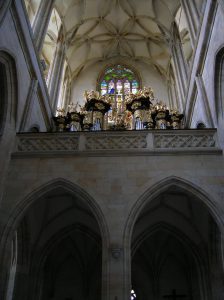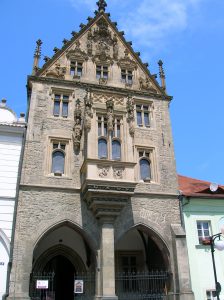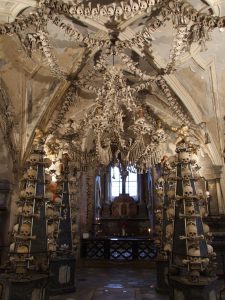Kutná Hora and the Bone Church – UNESCO Site
By Tracy A. Burns
Absorb the medieval atmosphere of Kutná Hora, a town on the UNESCO World Heritage List, where silver mining and coin minting have played significant roles in its history. With two cathedrals, a creepy and unique ossuary, and museums as well as churches, Kutná Hora makes a fascinating day trip from Prague.
History of Kutná Hora
The mining of silver enabled the town to prosper from the 13th to 15th centuries. At one time, the mine in Kutná Hora was the deepest in the world, and its silver was exported to one-third of Europe. This is where the Czech currency, the Prague groschen, was forged in the Middle Ages. While the mines and towns were decimated during the Hussite wars of the 1420s and later during the Thirty Years’ War, the mining era in Kutná Hora was far from over. It even operated from World War II to 1991.
 The Cathedral of Saint Barbara
The Cathedral of Saint Barbara
Yet Kutná Hora has more to offer than just mining. Perhaps the highlight of the town is Saint Barbara’s Cathedral, named after the miners’ patron saint. Built-in 1338 and, after many interruptions, finished in 1905, the cathedral boasts many Baroque works of art, including three Baroque chapels, as well as late Gothic frescoes associated with mining. Its outer buttresses and gargoyles complement a Neo-Gothic façade. The oldest piece in the three-nave structure is the statue of Our Lady Enthroned, hailing from 1380. Stained glass windows are much more recent, dating from the end of the 19th century and the beginning of the 20th century. Look closely and notice the cathedral in the background of two of the exquisite windows. The late Gothic décor of the frescoes dotting the cathedral comes from the end of the 15th century. In the Mint Chapel frescoes depict miners striking Prague groschens with mallets, while in Smíšek’s Chapel the Smíšek family can be seen gathering around an altar. A mammoth fresco in another chapel shows Saint Christopher carrying the Christ Child on his shoulders. In the 1746 mural “The Vision of St. Ignatius Wounded in the Battle of Pamplona,” angels zoom through pink air. The stone pulpit was executed in 1560. Even the pews are adorned with ornate decoration.
 The Stone House
The Stone House
Don’t pass up museums in Kutná Hora, either. The Stone House harkens back to the era before the Hussite period of the 15th century, though it was last reconstructed at the turn of the 20th century. Its richly decorated Gothic façade fascinates, even with its grim theme of death. Notice Adam and Eve under the tree in the gable. The exhibitions here are both eclectic and exciting. Its lapidary or stone collection boasts stone fragments from medieval times, such as segments of the outer buttresses of the Cathedral of Saint Barbara. Part of the first floor features objects from the city’s former guilds while Baroque and Biedermeier furniture can be seen in a different spaces. Relics from religious orders capture the visitor’s attention as well. A sculpture of Saint Mary surrounded by miners depicts the saint with a star-studded golden halo, her hands clasped in prayer. A scullery, showing how food was prepared before the stove was invented in the 19th century, is also on display.
Hrádek and the Italian Courtyard
Now a museum about the town, mining, and silver, Hrádek or The Small Castle became a royal residence during the early 14thcentury. The building is decorated with a Renaissance coffered ceiling from 1493, halls featuring late Gothic ribbed vaulting, and the medieval Saint Václav Chapel with wall paintings of Czech saints. Visitors can travel deep into the medieval mine here as well. Housing a museum about mining and the town, the Italian Courtyard once served as an aristocrat home, too, and also operated a mint. The Prague groschen was first minted in this structure hailing from the end of the 13th century. Kings of Bohemia were no stranger to the Italian Courtyard, and Vladislav of Jagollen was elected King of Bohemia here in 1471. The royal chapel is a gem in Gothic style, dating from 1386, and features a winged altar adorned with a relief of a dying Virgin Mary.
Other Sights
There are still more sights in the town. Dramatically leading up to the cathedral from the former Jesuit College, which is now an art museum, are 12 statues of saints, constructed from 1650 to 1716. Take a walk down Ruthardka, a romantic and picturesque street meandering through the center of the town. A Baroque plague column decorates one of the squares. A stone fountain with 12 sides adorns another square and hails from the end of the 15th century.
Sedlec´s Cathedral
Sedlec, on the outskirts of Kutná Hora, is dominated by the oldest cathedral in the country and an ossuary. The Cathedral of the Assumption of the Virgin Mary and Saint John the Baptist, a UNESCO site since 1995, was constructed from 1282 to 1320 and renovated in Baroque Gothic style by master architect Jan Blažej Santini-Aichel. Seven chapels and renderings of saints astound, including three paintings by Baroque master Petr Brandl. Baroque confession booths hail from 1730. The reliquaries holding Saint Felix’s and Saint Vincent’s relics were donated by Pope Benedict XIV in 1742. The Chapel of the Virgin Mary of Sedlec amazes with elaborate Ionic columns and plump putti with angels. Statues in the cathedral include a haloed Saint Benedict holding an open book.
 Ossuary – the Bone Church
Ossuary – the Bone Church
Also in Sedlec, the All Saints Chapel goes back to the 14th century while the cemetery, hailing from the 13th century, is the resting place of many plague victims and fallen soldiers from the Hussite wars. In 1511 a half-blind monk piled bones from abolished graves into pyramids. The Schwarzenberg clan purchased the ossuary and surrounding area in 1784 after architect Jan Santini Blažej-Aichel had done the renovation in his unique Baroque Gothic style. The Schwarzenbergs had the idea to put the bones and skulls of the 40,000 bones into various shapes, such as a large chandelier, a Gothic tower, a chalice, and the Schwarzenberg coat-of-arms with bones depicting a severed Turk’s head and a raven. Skulls from soldiers during the Hussite wars of the 1420s are also on display in this unique, impressive space.
Medieval Spell…
Whether you want to stroll down medieval streets, explore a medieval mine, tour cathedrals or visit an ossuary and museums, Kutná Hora has something special to offer every visitor intrigued with the Middle Ages in Central Europe and casts a magical, medieval spell on its tourists.




